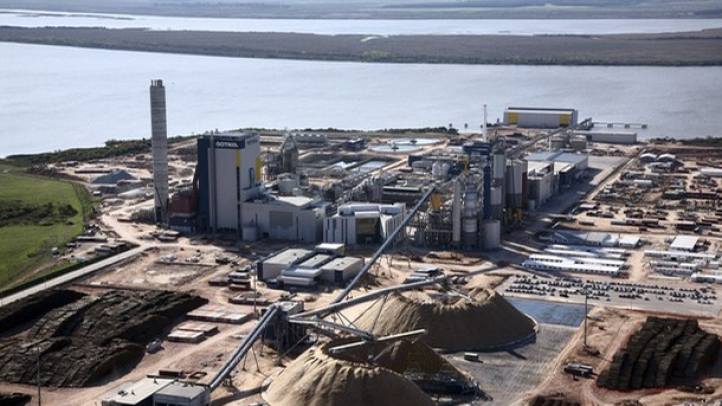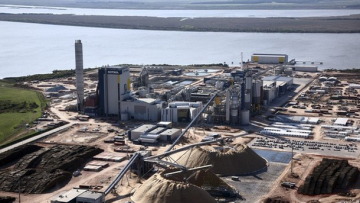Project – On record
This profile is no longer actively maintained, with the information now possibly out of dateBankTrack
nature@banktrack.org

Project – On record
This profile is no longer actively maintained, with the information now possibly out of dateBankTrack
nature@banktrack.org
| Sectors | Pulp, Paper and Paperboard Mills |
| Location |
|
Against massive local resistance, from residents and environmental groups, despite the opposition of the Government of Argentina, and despite an escalating bilateral conflict between two otherwise friendly neighbors caused by the project (Argentina and Uruguay), the Finnish pulp company Oy Metsa Botnia inaugurated in November of 2007, one of Latin America's largest pulp mills on a border river between Uruguay and Argentina. As recent as April 2008, tens of thousands of people marched peacefully on the border to oppose the investment.
The plant is located on the Uruguayan shores of the Uruguay River, the major international waterway between Argentina and Uruguay. The site location is dangerously and controversially ill-placed, just a mere kilometer away from the drinking water intake of Fray Bentos, an Uruguayan city of 35,000, and about 12 kilometers, directly facing Argentina's prime tourist beaches and vacation resorts, at the locality of Gualeguaychú. Botnia failed to consult or address the concerns of local stakeholders, including Uruguayan environmental groups, and the entire community (population 80,000) who live just across the border from the mill site but entirely within the established zone of impact (as determined by the World Bank).
Local stakeholders point to a condemning audit by the World Bank's Compliance Advisory Ombudsman (CAO) which was completely ignored by the International Finance Corporation (IFC) and by Botnia as the project went forward with World Bank financing. Since November 2007 stakeholders have already been sensing and complaining about the foul odors typical of pulp production, emitted by Botnia. Botnia claims it has done everything by the book, that is has necessary operating permits, that it does not contaminate, and that the deep conflict that has arisen has nothing to do with them.
Environmental and climate impacts
The environmental impacts of the project include:
- the extraction of extremely large quantities of water from the Uruguay River;
- the generation and spillage of waste products from the pulping and bleaching stages of paper production;
- the contamination of waters used for drinking;
- the death of and risk to the sustainability of fish populations of the Uruguay River critical to the local environment and to the livelihoods of a great many fisherman of the region;
- the emission of odorous gases;
- noise pollution from the construction and operation of the plant and from vehicle movements;
- the high risks of spillage or explosion of chlorine products for use in the paper making process;
- great risks to the tourism industry, central to the identity and livelihoods of local populations.
Other impacts
Private banks Nordea and Calyon, along with the IFC, MIGA and Finnvera have financed the project, despite the unfavourable CAO audit, and despite an unresolved international complaint filed by Argentina against Uruguay at the International Court of Justice alleging violations of international law (which had also drawn concern from the World Bank's legal counsel), and despite an outstanding complaint at the Inter-American Commission on Human Rights regarding Uruguay's HR violations of Argentine communities.
The pulp factory, one of the largest in the world at more than 1000 tons production per annum, utilises Elemental Chlorine Free (ECF) technology, a process that incorporates chlorine dioxide in the bleaching process and produces dioxins, which are persistent organic pollutants and endocrine disrupters, linked with a myriad of health and environmental problems. Botnia was unable in early stages to convince the IFC, IFC's independently hired consultants, or local communities, that they were indeed (as claimed), using the Best Available Technologies (BAT) for ECF production. The company was forced to return to the drawing board for nearly 18 months, as the project had to be reconfigured to meet IFC standards.
Meanwhile the conflict around the investment, intensified. Botnia has been systematically refusing to engage in any real dialogue with communities, except to insist that their project is harmless; neither have they been willing to engage with the Argentine government or the Uruguayan government, about relocation options, long before they ever set a single brick in place. Botnia scrapped all hopes for a solution to the conflict when it refused to enter into a bilateral agreement between Argentina and Uruguay for a 90-day moratorium on construction. Another mill which was planned alongside Botnia by the Spanish company ENCE, did enter into the agreement, and halted plans on construction. That mill subsequently decided to relocate within Uruguay and moves forward without problems.
The sulphur-based atmospheric emissions caused by pulp production are incompatible with Botnia's location choice, in a pristine environmental region in a zone that is relies heavily on tourism and the beauty and tranquility of the natural environment. This choice of site for the project is very much at the heart of the conflict and highlights the growing importance that today's societies and the international development finance community give to "social license", the idea that projects must be embraced by communities to be economically, politically and socially sustainable.
In fact, the uprising and social movement which exists today in opposition to the investment, is perhaps the largest recorded opposition to a World Bank investment, having mustered each year, on the yearly anniversaries of the first popular uprising against the project, 50,000, 100,000, 120,000, and 80,000 persons in peaceful marches against Botnia and sustaining a growing massive regional movement which has surpassed the most extraordinary expectations anyone could have had regarding the opposition.
The Uruguayan government, buttressing itself with 19th century legislation used then to disband political opposition to incumbent governments (repudiated by many as being unconstitutional), has chosen to quell rising local and international protests by banning foreign journalists (from Argentina) from attending public gatherings involving Botnia, while stakeholders have been banned from protesting at the Botnia site, or even meeting in Uruguay to organize against the investment.
The CAO Audit against the IFC's handling of the project, highlighted numerous breaches by Botnia and IFC of the IFC's environmental and social safeguard policies, which in the initial stages of the investment and its design, ignored the cumulative impacts associated with the nearby Spanish mill project, and completely ignored potential impacts on the Argentinean side of the Uruguay River. IFC even declared to its Board on April 22, 2005, that the project "enjoyed broad public support". Only 10 days later, the largest march ever against an IFC-supported project took place.
The negligence with which the mill proposal was prepared both by Botnia and IFC, was magnified by both institutions' refusal to address the massive opposition caused by the project, and their insensitivity to the growing local and bilateral conflict it was causing. It has even been a critical source of problems to the MERCOSUR trade block, from which Uruguay has repeatedly threatened to withdraw, not to mention its nefarious effect to what have been, until now, excellent bilateral historical relations between Uruguay and Argentina.
The project is criticized for doing almost everything wrong in terms of its corporate social responsibility (CSR) and compliance with social and environmental norms. This includes: seriously flawed EIAs; the signing of a draconian bilateral treaty to lock in corporate benefits, in detriment to the local public interest; lack of information to communities; lack of engagement at key decision-making moments; failed stakeholder consultation; establishment of tax-free havens for foreign profit; complete disregard for the negative impacts of the natural resource extraction and depletion caused to the host country to feed the production brought by the investment; paying workers minuscule amounts compared to what the mother company pays at home; poor treatment of local workers in case of accidents and risk situations; and complete disregard for local concerns.
On November 20th 2006, on the eve of the World Bank Board of Directors vote to finance Botnia (which would open the floodgates for other international finance from Calyon, Nordea, Finnvera, SEB, NIB, etc.), the community took to the key terrestrial border crossing on the international bridge linking Uruguay and Argentina and blocked traffic indefinitely in protest to the World Bank Board vote. They have remained on the bridge ever since, having now surpassed the 500-day marker in a full international terrestrial roadblock between the two countries at the major one of only 3 terrestrial crossings available all along the border. Botnia ignores this predicament and says it is not to blame, since formally, it has done everything right.
Following the World Bank decision to finance Botnia, the names of the Board of Directors of the World Bank to vote in favor of the loans have been added to an outstanding criminal complaint against the company for violations to the human rights of local stakeholders. Botnia Directors were summoned to appear in Federal Court in Argentina for questioning by the judge in the case. When the court date came up, Botnia’s Directors failed to appear.
When Botnia began operations in November 2007, Uruguay, fearing possible aggressive reactions from local community stakeholders, decided to close the borders fully, and has on occasions, officially closed all terrestrial traffic between the two countries, the first time this has happened anywhere in the region.
Botnia, which has always sold itself as a responsible company, standing on the Finnish reputation as responsible environmental stewards, complying with BAT, with CSR, and promising a sustainable and healthy environment, has already had 4 serious accidents, since launching production. This adds to accidents which occurred during its accelerated construction (to beat a ICJ court ruling that could order the dismantling of the mill). As a result, workers have been exposed to toxics, had limbs amputated, and there has even been one death on the Botnia site, due to accelerated construction and lax work safety regulations. Botnia argues that they are not responsible for any injury of death because the victims work for sub-contractors.
Several specific instances have been filed against Botnia and its financiers for violations to the OECD Guidelines for Multinational Enterprises, which include a complaint against Finnvera for its complicity as a state-owned bank, and against Nordea, for failing to provide stakeholders with basic information about its involvement in the project.
2010
2010-08-30 02:14:11 |
On April 20, 2010, the International Court of Justice in The Hague, the Netherlands ruled in the case that Argentina filed against Uruguay that Uruguay violated international law when it unilaterally decided to allow Botnia to build its pulp mill on the river. However, it also ruled that Uruguay is not obliged to order the mill's removal. Residents of Gualeguaychú are outraged by this ruling and have rejected it. They pledged to continue the four year long blockade of the bridge, that connects their city with Fray Bentos. The roadblock remained in place initially after the verdict, but following an Argentine government legal action to bring the protesters to trial under criminal charges, the roadblock was finally removed
A few months after the verdict the newly instalt Uruguayan President Mujica struck a deal with the Argentine President, to promote a joint monitoring program of the mill, which community members have not been happy about, since over the last several years, the government has very much eased up its concern over the Botnia mill.
2006
2006-07-10 00:00:00 | Argentina takes Uruguay to the Internation Court of Justice in The Hague
In June 2006, the Argentina government took the Uruguay government to the International Court of Justice in The Hague, for failure to notify them about potential pollution from the mill. They also accuse Botnia of breaching Organisation for Economic Co-operation and Development guidelines, the 1975 Statute of the River Uruguay and the Equator Principles, a system of guidelines for assessing social and environmental risk based on standards set by the World Bank's private sector lending arm.

